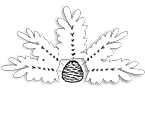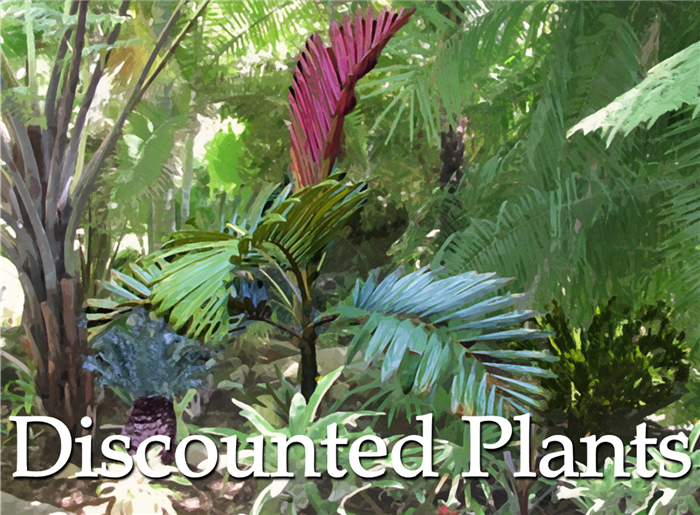Six Species –
Description, Growth & Culture
by Phil Bergman
Description of Article
This article discusses King Palms and all six species within the genus of Archontophoenix. Covered are characteristics of each species within this group, comments on cultural needs, care and usage in the landscape.
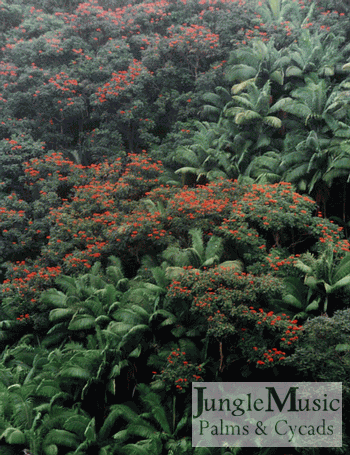
on the Big Island in HI
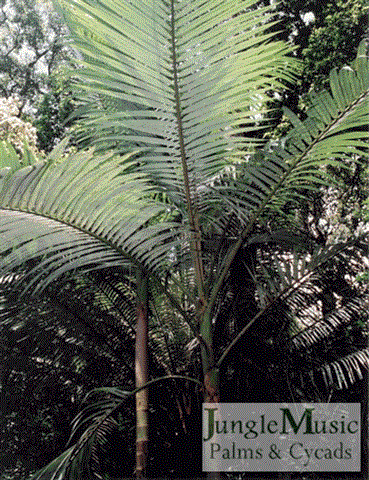
Archontophoenix purpurea
Introduction
King Palms are actually a group of species within the genus of Archontophoenix. As discussed below there are six different species in this genus and all are from Australia. There are differences between all of these species and this includes overall size and appearance, color of the crown shaft, the undersurface of the leaflets, seeds and flower traits. From a landscape point of view, King palms are very popular and planted widely throughout the world. But, the most common species, Archontophoenix cunninghamiana, is the only species most gardeners and even some landscape architects are familiar with. When the gardener says “King Palm”, it’s the cunninghamiana that he’s referring to. He may not even know there are five more types of King Palms.
After reading this article, the reader will hopefully understand the differences between the various species of this genus and understand their usage in landscape and the cultural requirements of the genus. I will start with a short introduction into the anatomy of a palm tree with specific comments on leaves and the crown shaft. Perhaps one can even decide which species of this group they like the most.
PARTS OF A PALM TREE – IMPORTANT TO KNOW SO YOU CAN TELL SPECIES APART
By comparing the different palm tree parts, you’ll learn the differences shown in the tables below.
To understand and identify palms, one must become familiar with the parts of a palm. Anyone who discusses the topic will give characteristics of and describe the parts of the plant. If you know the terms used to describe the tree, then you’ll begin to understand what is being discussed. This may be elementary to some readers, but is critical to understanding. So, below I’ll talk about the various basic parts of a palm tree. Below, to start instructing you about Archontophoenix, I’ll only show pictures of the King Palm family.
The Trunk
This is the supporting structure of the tree. They begin at ground level and typically go up to the crown of leaves at the top of the trunk. Depending on the species of palm, trunks can be quite thin, even less than a half of inch. Or, they can be up to four feet in diameter. And, the height of the trunk can be non-existent up to almost two hundred feet. With exposure to sun, palm trunks become woody but do not have bark. They may retain a green color if not exposed to direct sunlight, but are usually a tan color.
Rings may be seen circling the trunk and are actually scars from where the old leaf bases attached to the trunk. In the sun the trunk surface is hard and slightly cracked. This woodiness provides protection from trauma.
Trunks have two purposes: support and nutrition. In general, the larger the crown of leaves, the thicker the trunk. But, this is not a steadfast rule. Secondly, the trunk is the “highway” for transport of water and nutrients from the ground up to the leaves of the tree.
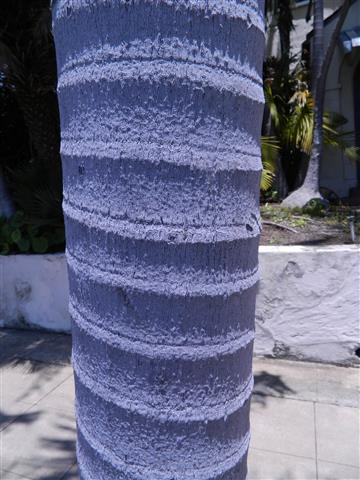
The Leaf
When we speak of a leaf, we are actually talking about everything from the trunk out to the end of the leaflets. But, taxonomists break it down further. The leaf has three parts. Closest to the trunk is the leaf sheath or base. this is what attaches to the trunk. Next out is the petiole, or the leaf stem that goes from the trunk to the green leaflets themselves. At the end of the leaf is the “lamina”, which is the sum of all the leaflets.
For the purposes of this article, we will be considering the “leaf” to be the lamina or that part of the green leaf which has the leaflets. On Archontophoenix, there are many leaflets to either side of the central stem. Because of this, it is considered to be a pinnate or ‘feather” type of palm species. Also, one must inspect the upper side of the leaf (dorsal side) as well as the underside (ventral side) for its color and presence or absence of small hairs. One would note if the leaflets are directly opposed to each other or staggered. And, also are the leaflets in one flat plane in cross section or do they emerge from the stem at various angles making them fluffy (plumose)?
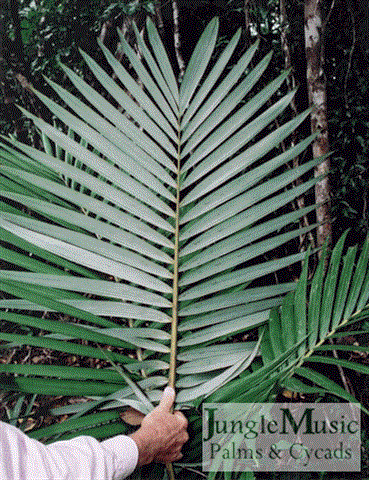
The Leaf Stem and Petiole
The bare leaf stem is known as the petiole. It is modified proximally to attach to the trunk using the leaf sheath or base. The petiole extends from the trunk out to the leaflets. The portion of the leaf stem that goes beyond the point where the leaflets begin is called the rachis. Together the petiole and rachis make up the entire leaf stem.
In cross section, petioles can be circular, flat or rounded with a flat side. They may be smooth or armed with spines, depending on the palm species. Their diameter size varies from the size of a pencil to the size of human waist on some species. Their length is also dependent on culture. Plants grown in shade tend to have longer petioles than the same species grown in strong sun. Young plants stretch for sun may also have long petioles. Sometimes their edges are razor sharp. In general, the larger and heavier the leaf, the fatter and stronger the petiole.
Petioles support the leaflets and are the means of delivering water and nutrition to the leaflets.
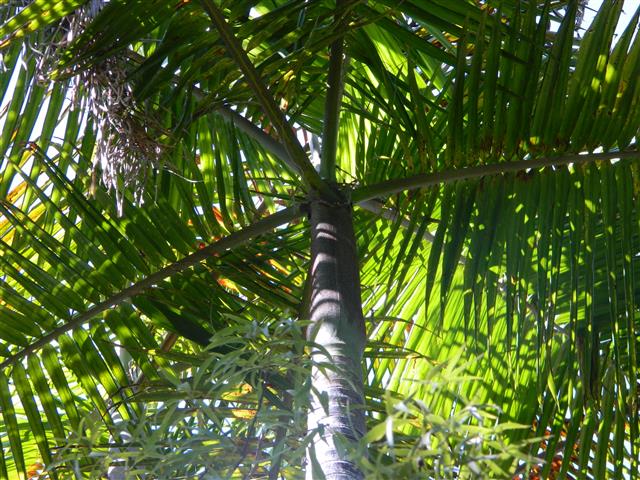
The Crown Shaft
As mentioned above, the petiole attaches to the trunk with the leaf base or sheath. On some species this sheath merely broadens out and fixes itself to the trunk. But, sometimes this sheath is modified to wrap entirely around the trunk of the tree. When it does this, one is left with what is called a “crown shaft”. It is below the crown of leaves and has no leaflets attached to it. A petiole does exit the top of the crown shaft.
This is what most people recognize as the smooth area of the trunk below the leaves. With Archontophoenix, it is smooth and an assortment of colors including lime green, a rusty green, purple and almost yellow. It is one of the palm palm parts that is used in identifying species.
As a crown shaft ages it turns colors. old crown shafts become brown and dried in appearance. If un-pruned, this old crown shaft will fall to the ground on its own. This is what is meant by being “self-pruning”. After dropping and on inspection, one can see how it “wrapped the trunk”.
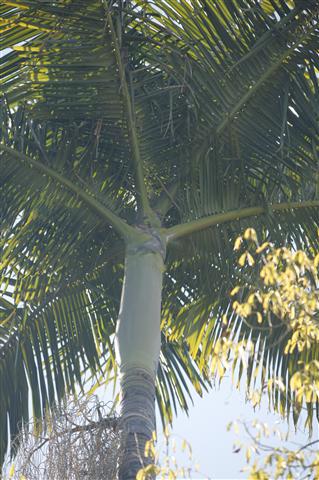
The Leaflets
The leaflets are the individual segments of the lamina (green leaf). The size, shape and length of these leaflets is totally dependent on the species considered. Most are green in color when mature. But, there are species of palms where the newly emerging leaf and leaflets are colored. Chambeyronia is a New Caledonia palm that has prominently red colored leaflets on newly emerging lamina.
Leaflets attach to the rachis and can be arranged in a flat plane or attached such that multiple ranks of leaflets are produced giving a plumose leaf. The leaflet tips may come to a point, be serrated or chopped at the end or curved. Not only is the width and length of the leaflets variable, but their two halves may point upward or downward. This latter characteristic is also a means helping to identify species.
The width of a palm leaflet usually diminished at the point of attachment to the rachis. Most don’t form a secondary “leaflet stem” but rather just diminish in width, get a bit circular and attach themselves to the side of the rachis. Caryota palms are the exception and “bi-pinnate”.
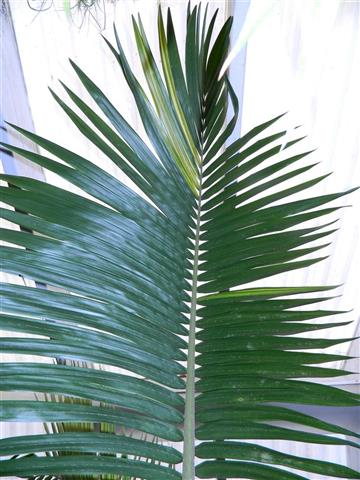
Flowers, Fruits and Seeds
Palm trees are Angiosperms. This means that they are a flowering tree. Palm flowers either emerge from within the crown of leaves or from the stem. With crown shafted palms, the flowers almost always emerge from below the crown shaft. Some palms are dioecious; this means that each individual tree is either a male or a female. Some palms are monecious; this means that any given tree has flowers of both sex. Regardless, the pollen must reach the receptive female flower in order to make viable seeds. .
When palm flowers emerge, they are initially green or a whitish-tan color. As they mature, they may become more prominently colored. Some palm blossoms are actually red or orange in color. Once pollination occurs, small unripe seeds form. With maturation and time, these seeds also will often be colored. The inner seed is hard and woody, but the outer fruit is colored. When immature, the seeds are usually green in color and won’t germinate at all or in a good fashion. One must only collect mature, colored seeds.
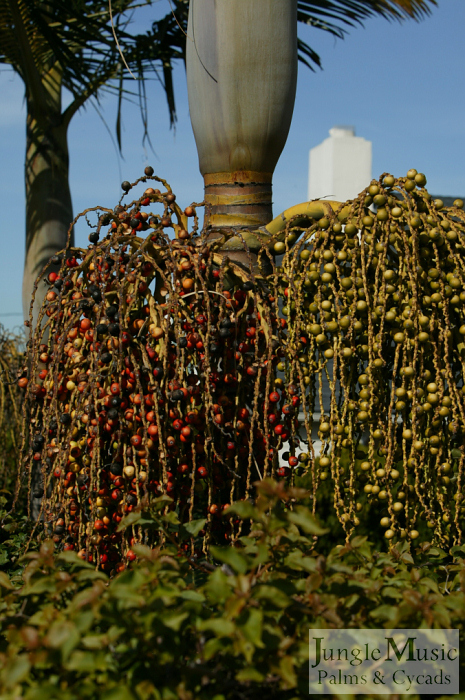
Underside of the leaflets
One would inspect the underside of the leaflets looking for two things: the leaflet color and for small hairs known as “ramenta”. The latter, ramenta, are a good clue to identifying the species you are looking at. (see next table)
As mentioned above, the underside of the leaflets of Archontophoenix cunninghamiana are green. All of the other species are a shade of silver. So, if you look under the leaflets and they are plain, dull green (below), then you are looking at the common Archontophoenix cunninghamiana
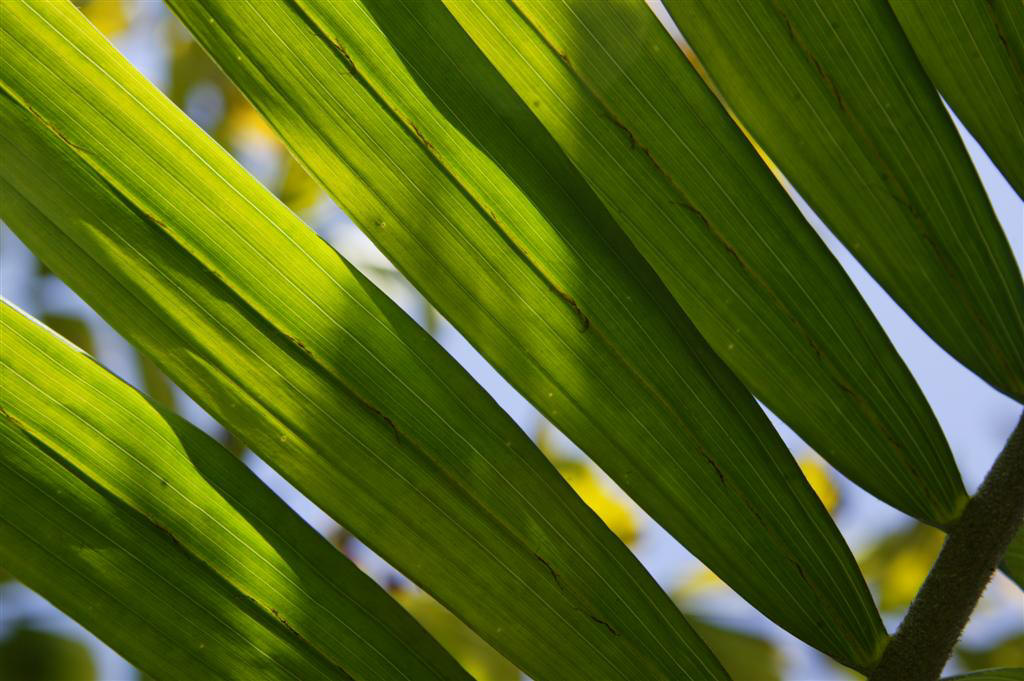
Ramenta
Ramenta are small, cark colored hairs seen on the underside of two species of Archontophoenix: A. cunninghamiana
A. purpurea
No other species of the King Palm have these hairs. “Ramenta” is defined as thin, chafflike scales on plant structures. Sometimes they are difficult to see and at other times it’s really easy to spot them. I’ve found that the hairs on A. purpurea are the easiest to spot. They are the linear dark hairs on the photo below.
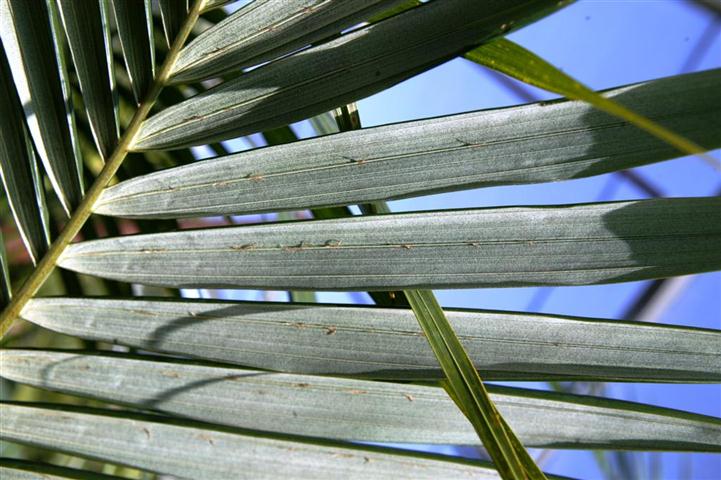
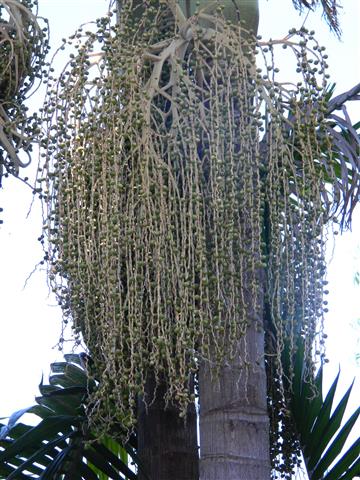
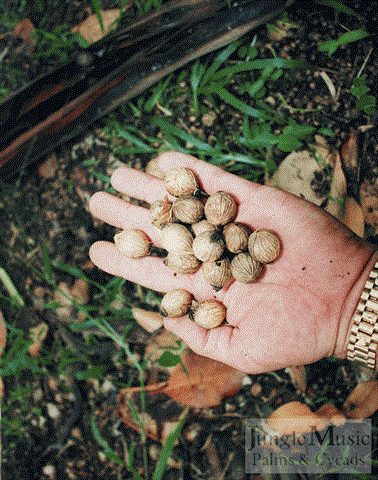
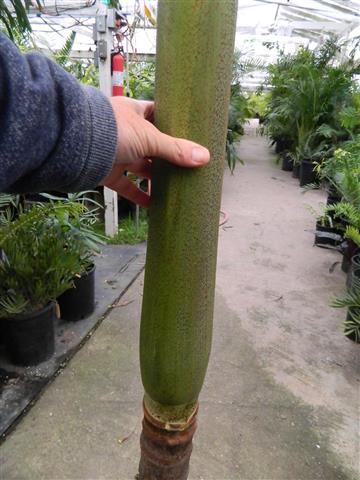
THE GENUS ARCHONTOPHOENX: GENERAL REMARKS AND NATIVE HABITATS
All “King Palms” belong to the genus of Archontophoenix. There are six species within this genus. All are from Australia. Individual species of Archontophoenix come from different areas of the Australian continent. It is important to know, when the average person says “King Palm” he is referring to Archontophoenix cunninghamiana. But, in fact, all species of this genus can be called by this term. With the genus, some species have their own common name as described below. All in this group are single trunk palms, all are pinnate in leaf form, and all have crown shafts. All have straight trunks with rings. They grow at elevations from sea level to about 4000 feet.
Except for Archontophoenix cunnighamiana, all have silver on the underside of the leaves. With one species, Archontophoenix maxima, this silver is faint but present. The flowers of all of these species are produced below the crown shaft. Flower color is variable, depending on the species. All species make red fruit although sizes are variable. The orientation of all leaflets within this genus are flat in leaf cross section although with some species the leaves will twist. But, Archontophoenix are not a plumose leaf palm.
DIFFERENT SPECIES OF ARCHONTOPHOENIX OR TYPES OF KING PALMS
ARCHONTOPHOENIX ALEXANDRAE
Common Name(s): Alexandra King Palm, Alexandra Palm, the Alex Palm
Native Locality: Northern and Central Queensland, Australia, both along the coast and inland
Overall Height: 70 to 80 feet in habitat but usually up to 40 feet in domestic gardens in sun
Trunk Diameter: 12 inches, sometimes swollen at the bottom. Young trunks brown, older gray
Leaf Length: 6 to 10 feet
Leaflets: Color dark to grass green, silver on the underside
Crown Shaft Color: Olive green, sometimes a bit brown mixed in. Slight bulge at bottom occasionally
Presence of Ramenta: Absent
Flower Color: White or near white
Seed Size: 1/2 inch
Other Comments: This species holds a nice large crown of leaves with a tall, fray colored straight trunk. There is a possible sub-species, that I will discuss below.
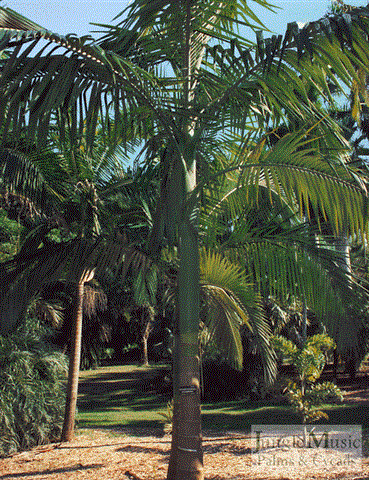
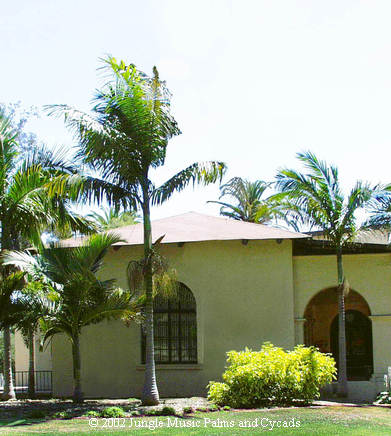
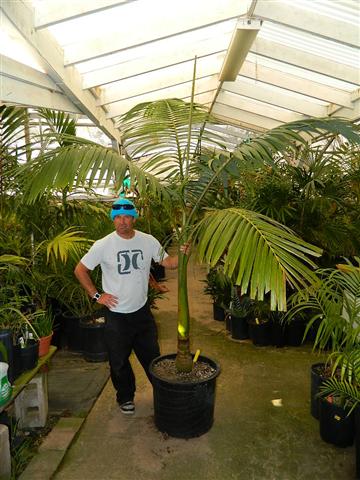
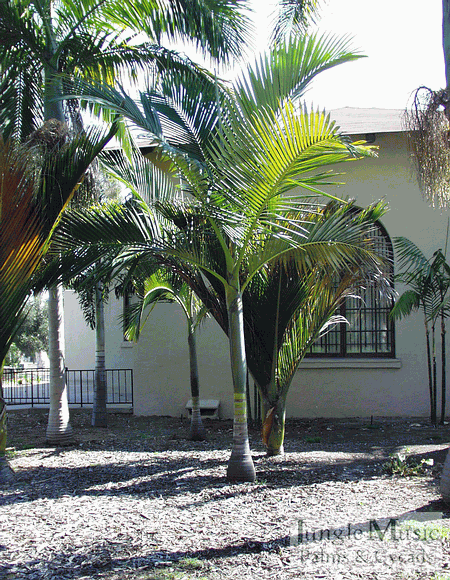
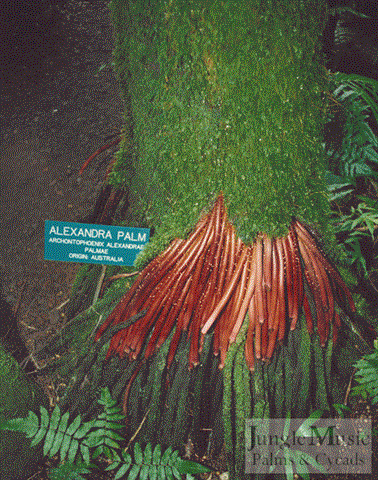
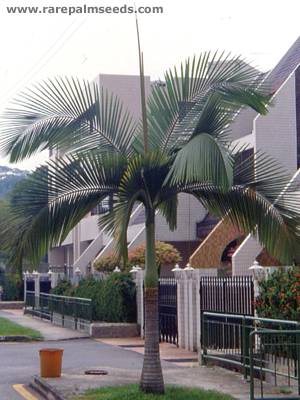
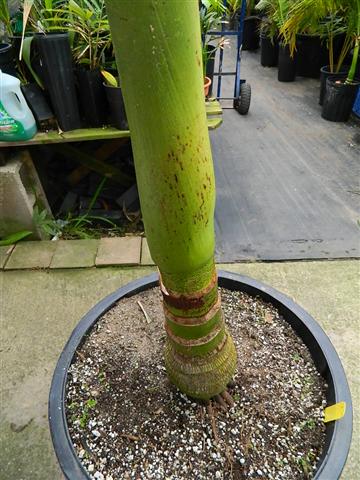

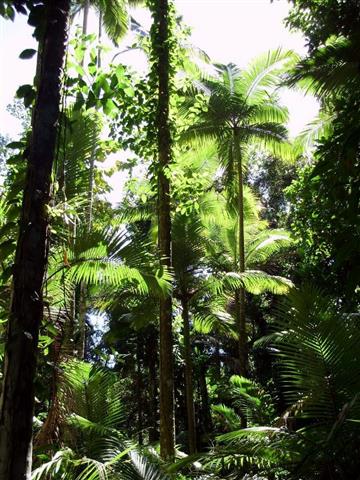
ARCHONTOPHOENIX CUNNINGHAMIANA, The more Common form of King Palm
Common Name(s): Piccabeen Palm, Bangalow Palm, Common King Palm
Native Locality: Eastern coast of Australia from Queensland south to New South Whales. Most southern species
Overall Height: In habitat up to 60 feet but domestic plants usually 35 to 40 feet
Trunk Diameter: 9 to 12 inches, gray and prominently ringed, in shade and when young green trunk
Leaf Length: 8 to 10 feet long, shorter in bright sun, bare petiole short in full sun
Leaflets: 2 to 3 feet long, olive green in filtered light, lime green in sun and slightly lighter green on underside. NOT silver! Also ramenta present
Crown Shaft Color: Green, often with brown prominently mixed in. Length 3 feet, shorter than A. alexandrae
Presence of Ramenta: Yes, on the underside of the leaflets
Flower Color: Lavender in color. Blossoms are larger than A. alexandrae
Other Comments: Most common King Palm seen in commercial and private plantings. Often planted as a “multiple”. Fast growing
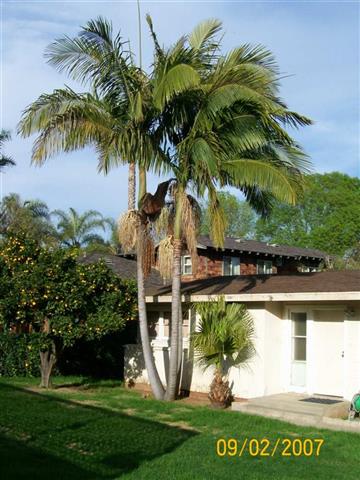
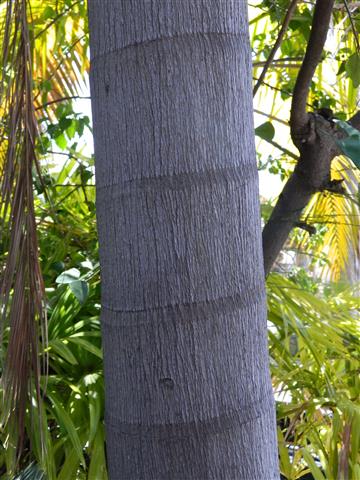
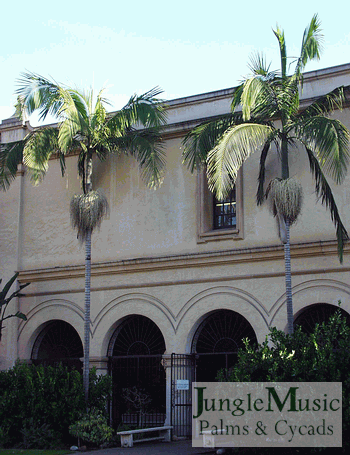
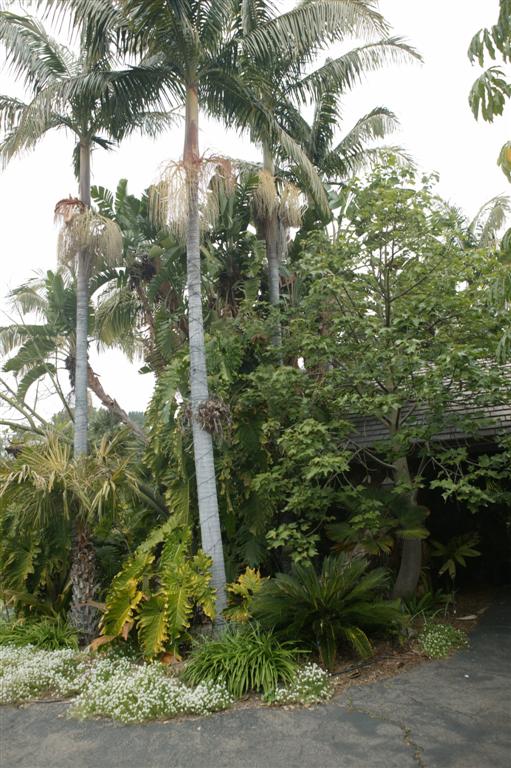
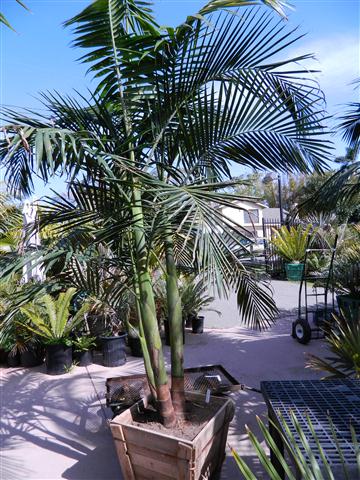

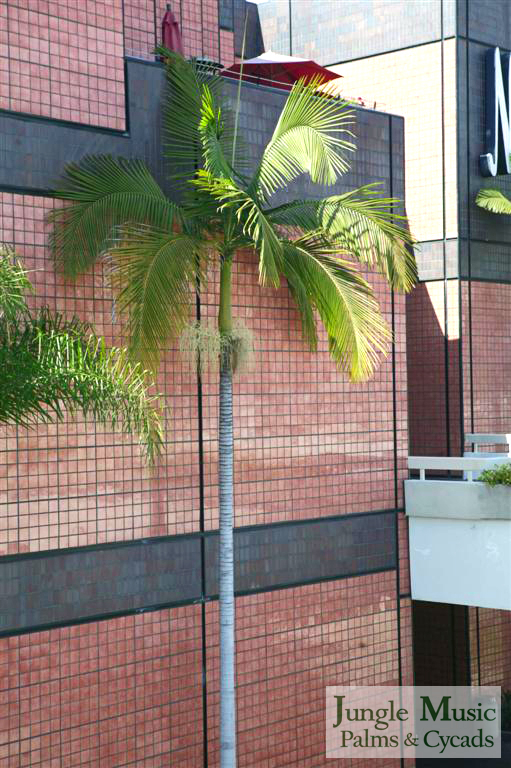


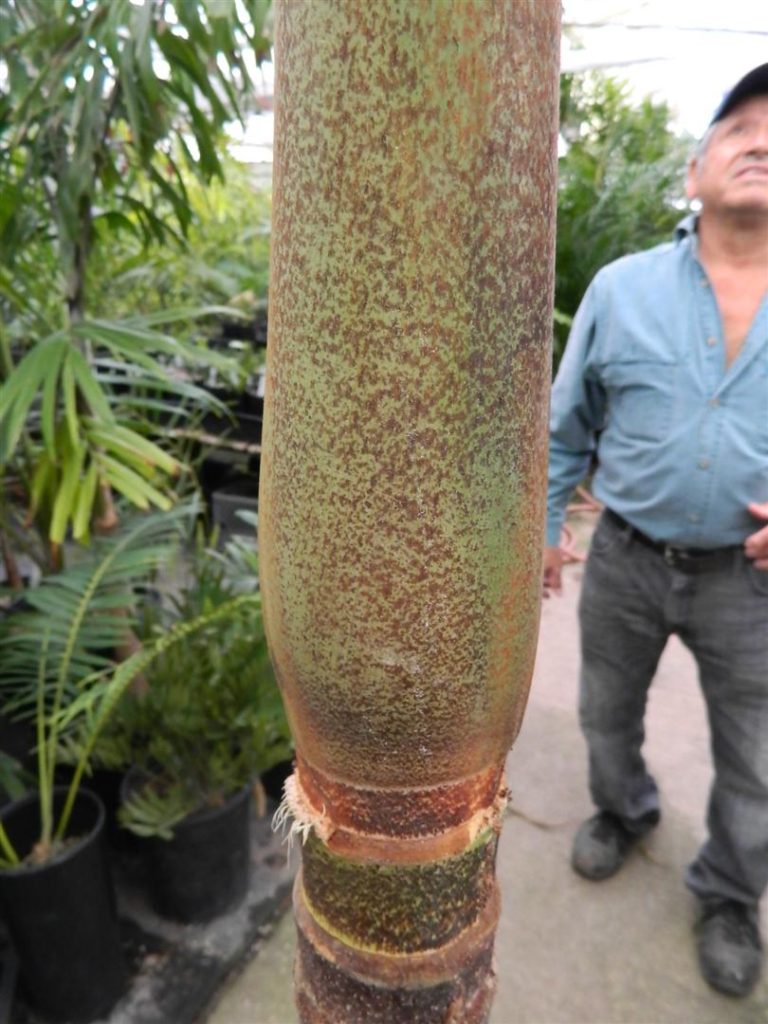

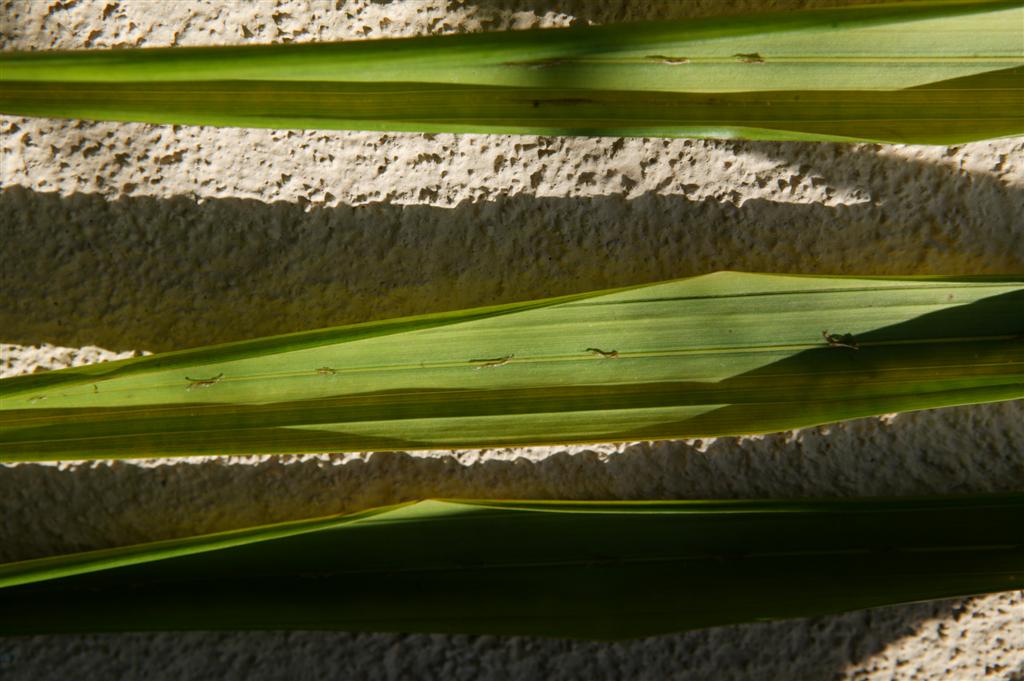
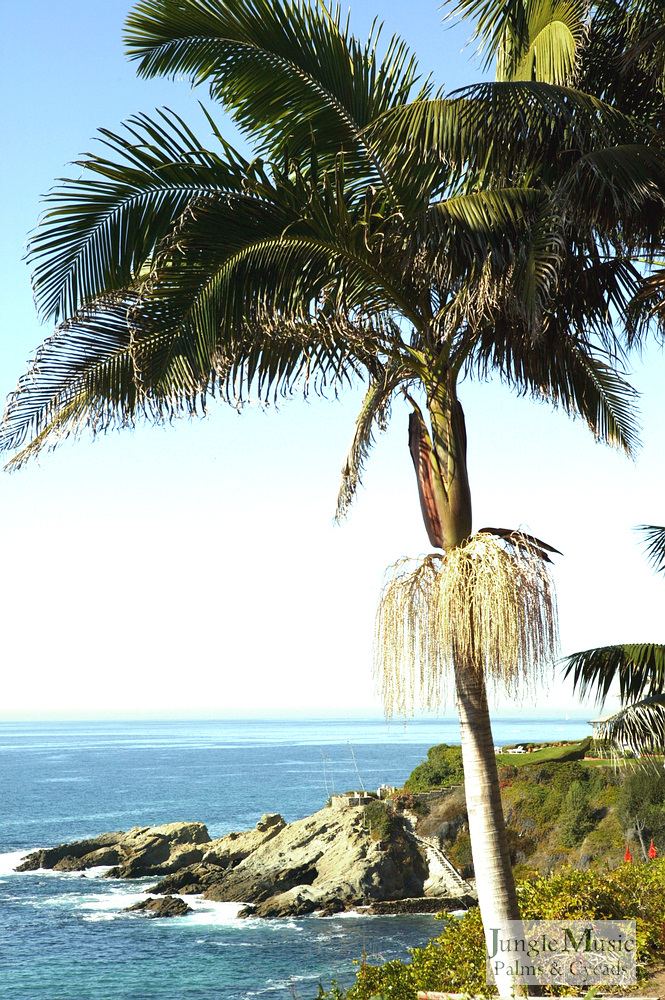
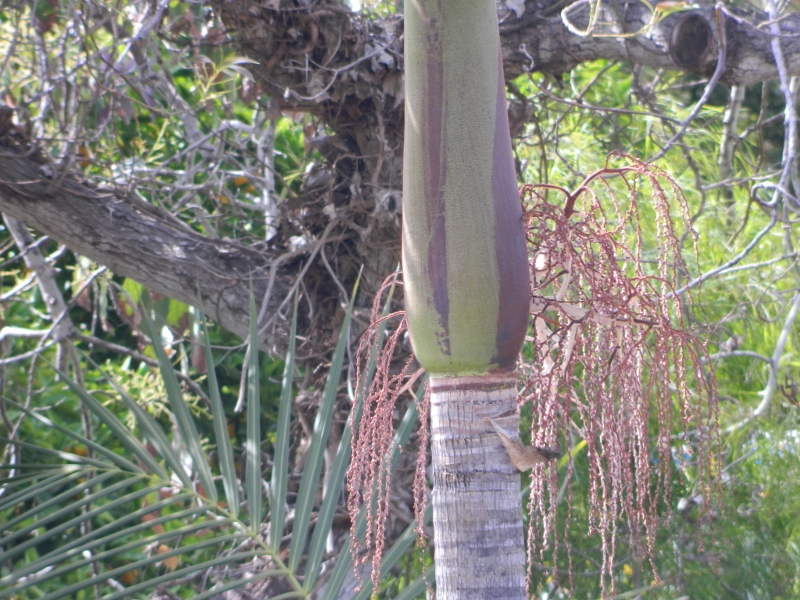
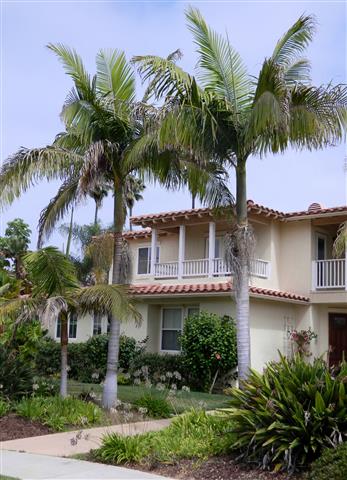
ARCHONTOPHOENIX MAXIMA
Common Name(s): Walsh River Palm
Native Locality: In the Atherton Tableland, south and west of Cairns, Queensland, Australia. Elevation there is 3500 feet.
Overall Height: In habitat up to 70 or 80 feet
Trunk Diameter: Thicker than all the other species, up to 18 inches. Some swelling at base.
Leaf Length: 10 to 12 feet, upright, slightly twisted. The petiole is very short, i.e. leaflets start near the trunk.
Leaflets: Minimally silver underneath (other species more prominent) and no ramenta
Crown Shaft Color: Green with hints of yellow or blue
Presence of Ramenta: Absent
Flower Color: Creamy-white in color. Note that this species has the largest flowers of any Archontophoenix
Other Comments: Probably the largest of the family. It has upright, rigid leaves (not arched) and a thick trunk. Good growing palm.
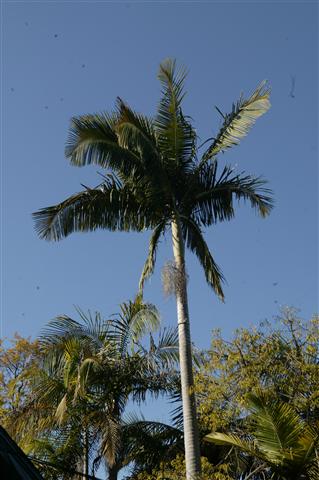
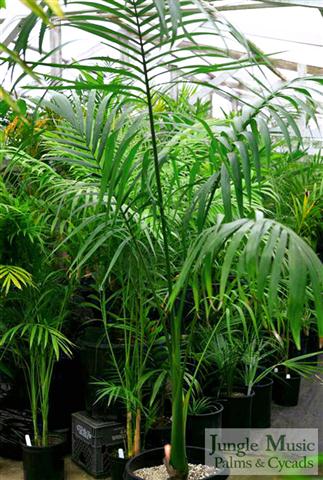
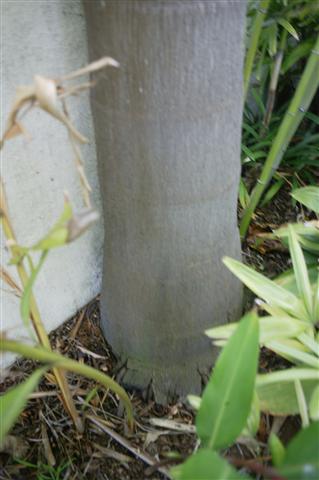
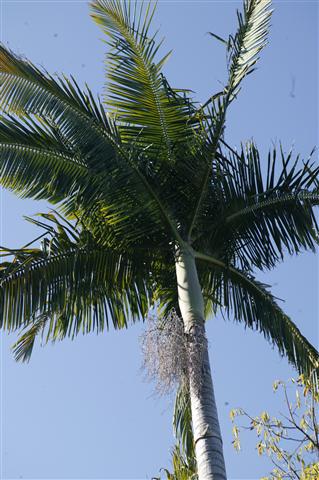
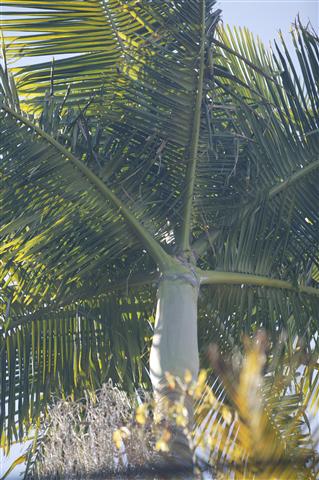
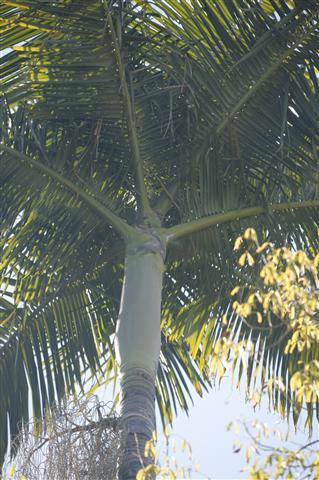
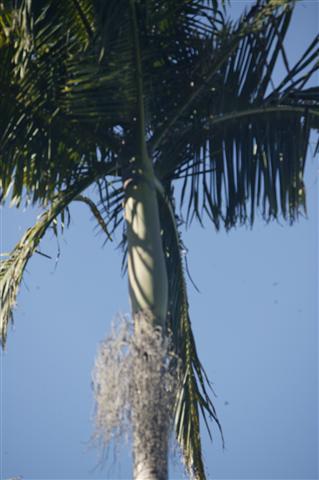
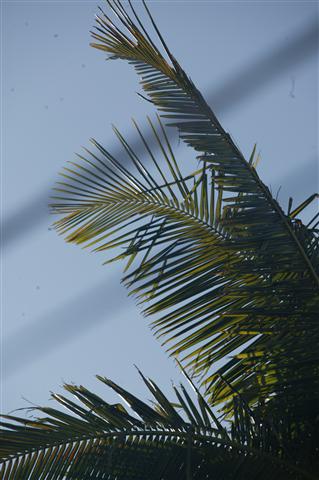
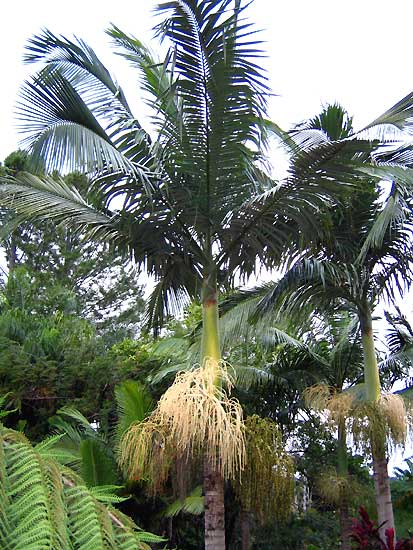
ARCHONTOPHOENIX MYOLENSIS
Common Name(s): Myola King Palm, named after a region in Queensland
Native Locality: Northeastern Queensland, outside the city of Cairns. Described in 1994 by John Dowe
Overall Height: Up to about sixty feet
Trunk Diameter: Approximately one foot in diameter, slightly swollen at the base
Leaf Length: 12 feet, mildly twisted along axis
Leaflets: Two to three feet long, silver underneath and relaxed on rachis. Note, leaflets hang down to some
extent on this species.
Crown Shaft Color: Emerald green or blue-green, very clean color. Crown shaft not mottled with brown
Presence of Ramenta: Absent
Flower Color: White
Other Comments: Graceful and pretty palm with arched leaves and leaflets that hang downwards
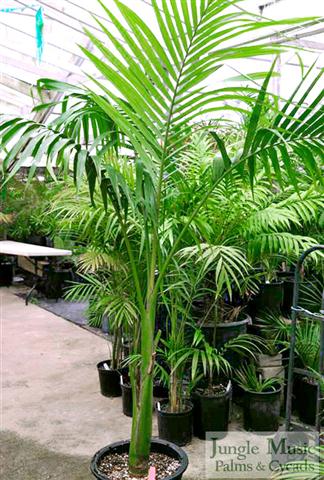
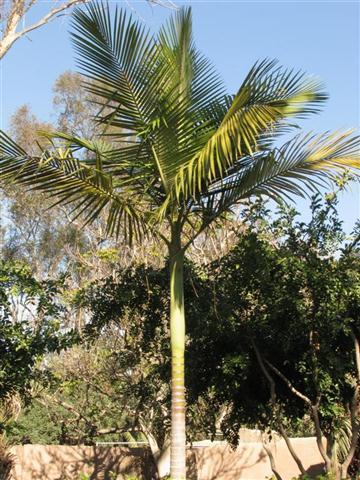

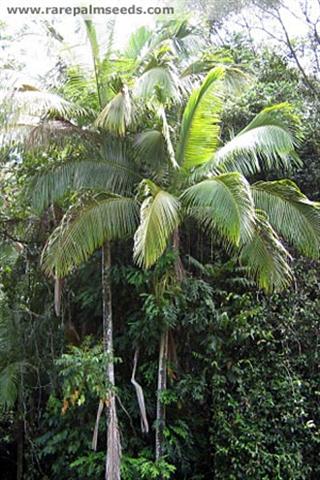
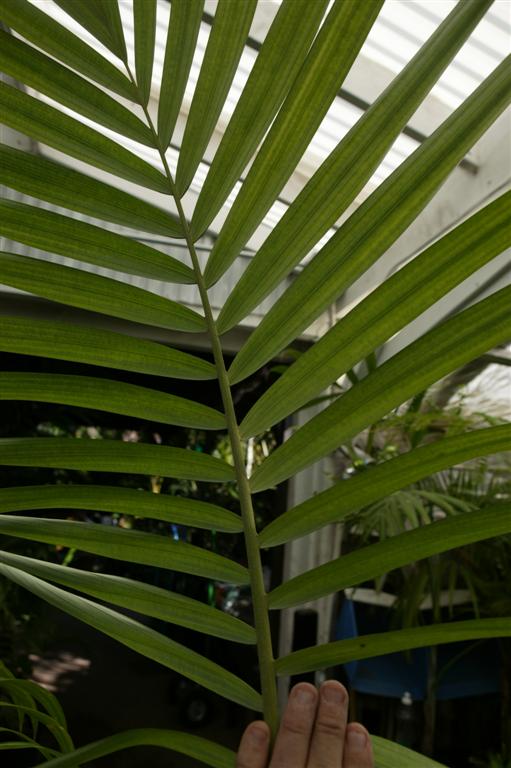
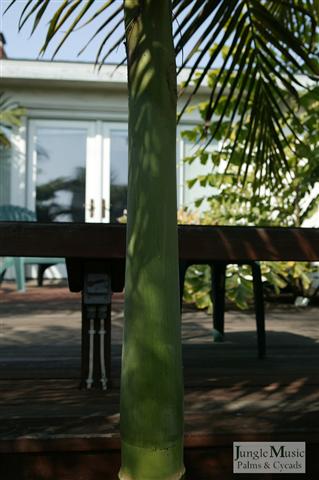
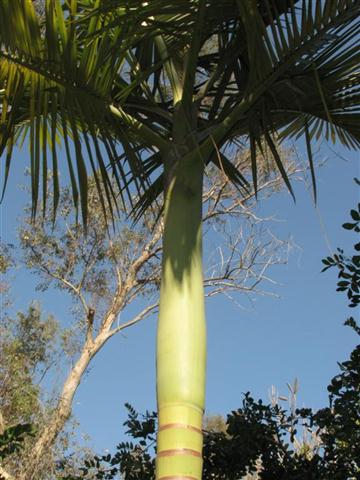
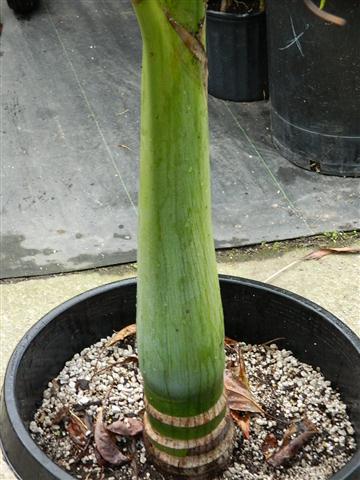
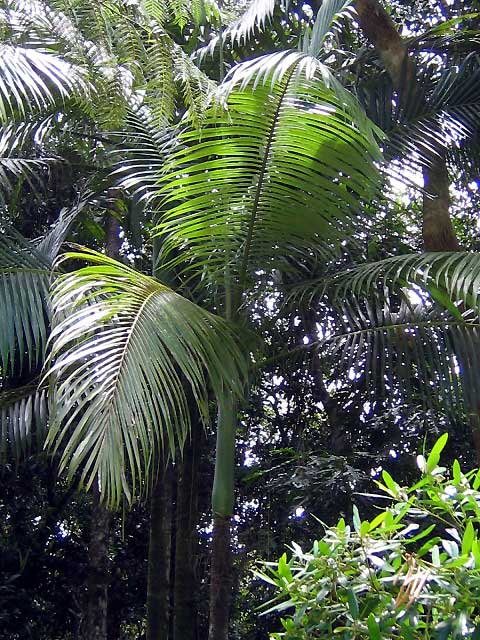
ARCHONTOPHOENIX PURPUREA
Common Name(s): Archontophoenix Mount Lewis, Purple Crown Shaft King
Native Locality: Mount Lewis Mountains, Queensland, Australia
Overall Height: Fifty to sixty feet, shorter in cultivation
Trunk Diameter: Twelve to eighteen inches, said to be the thickest of the group but in my experience not as thick as maxima
Leaf Length: Eight to ten feet
Leaflets: About three feet long, drooping, very silver underneath
Crown Shaft Color: Purple or red-purple, sometimes with a bit of green
Presence of Ramenta: Yes, prominently so
Flower Color: Purple in color, seeds large
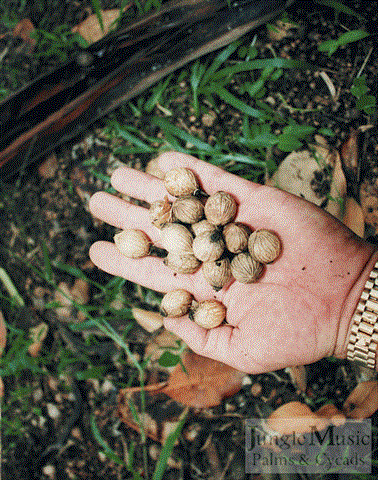
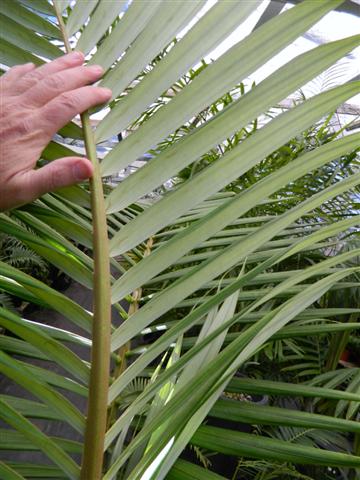
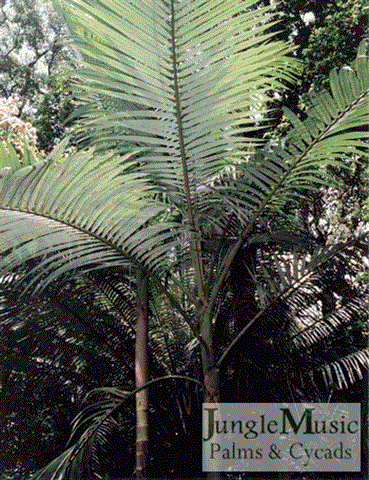
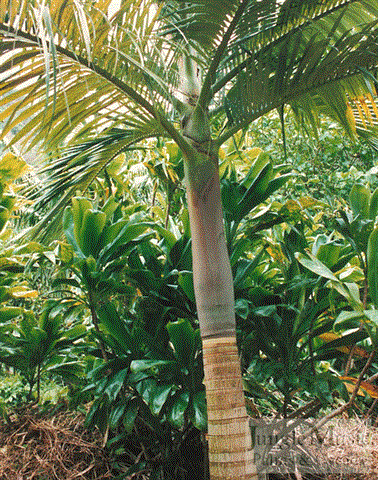
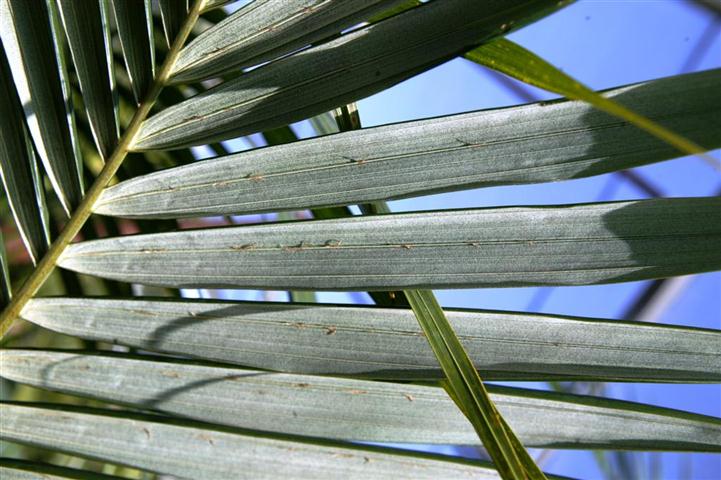
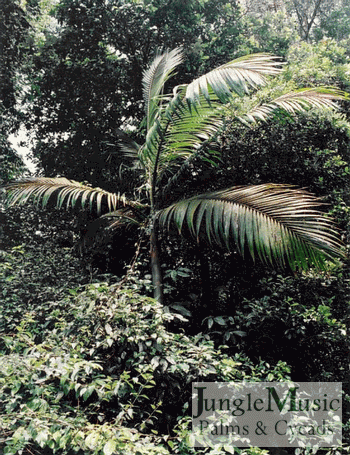
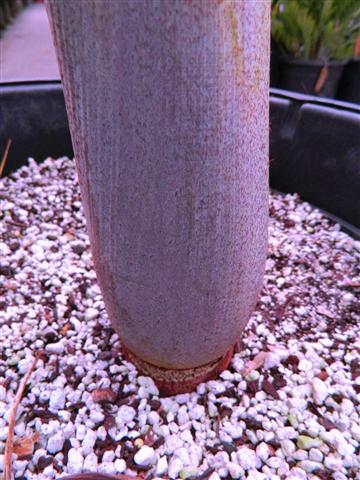

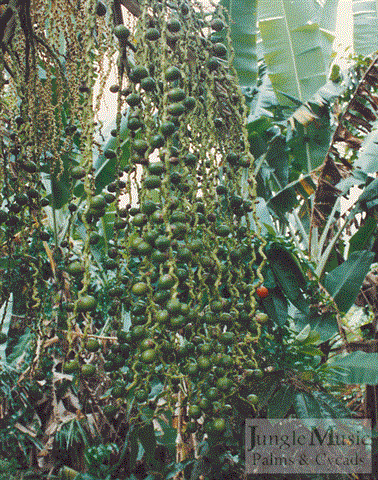
ARCHONTOPHOENIX TUCKERI
Common Name(s): Archontophoenix Peach River (Creek)
Native Locality: Cape York Peninsula, Queensland, Australia
Overall Height: Maximum sixty to seventy feet
Trunk Diameter: Ten inches
Leaf Length: Nine to ten feet, moderately twisted
Leaflets: Silver underneath, somewhat pendulous or drooping.
Crown Shaft Color: Green
Presence of Ramenta: Absent
Flower Color: White or cream colored
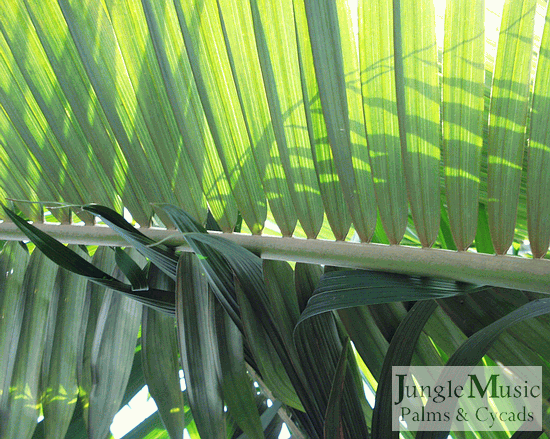
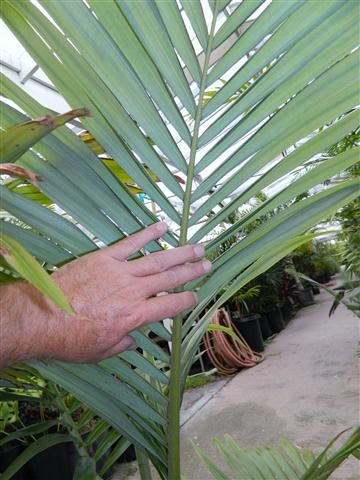
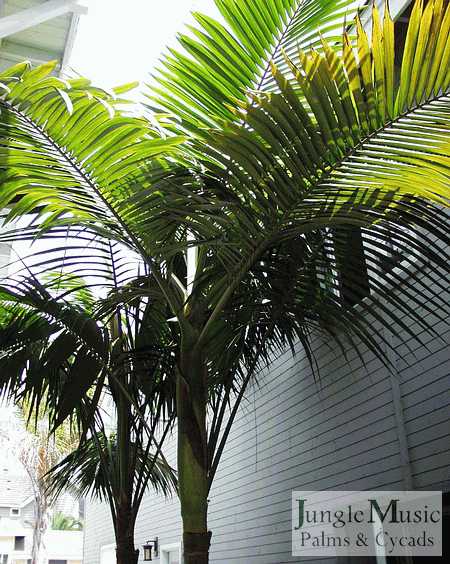
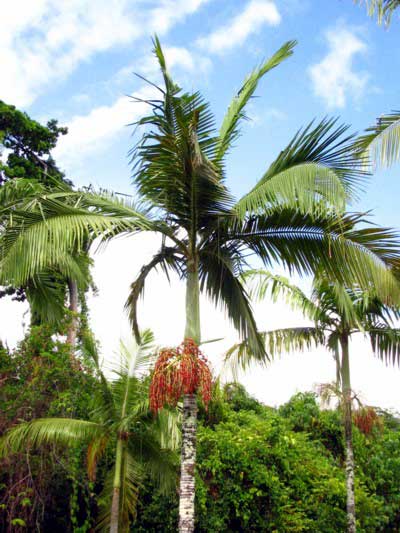
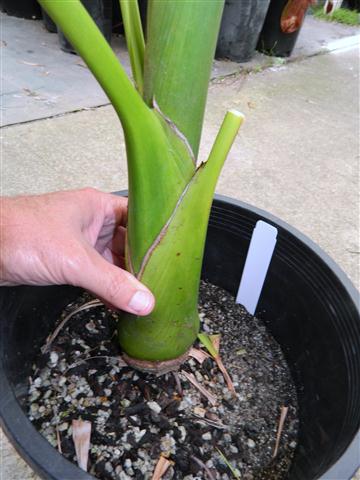
KING PALM CULTURE
COLD AND HEAT TOLERANCE
Archontophoenix are native to the eastern part of Australia, especially along the coastal areas. In habitat they see warm and sometimes humid weather and rarely a frost. What we’ve found from domestic usage of these species is that they cold burn badly at 24 to 25 degrees F. With colder temperatures, they are usually die below 23 degrees F. On the high end, they can tolerate temperatures of near 100 degrees if they are watered heavily and do better if not in full sun with such temperatures.
SUN EXPOSURE
In areas of high humidity, all Archontophoenix tolerate full sun. But, if you live in Southern California where the air is more dry, full sun can result in some burn to the leaves. This is particularly apparent on the tips of leaflets where “tip burn” is often seen. King Palms that get less than full sun, and especially just morning sun, are often more beautiful and without sunburn blemishes. Areas that are inland must plant their King Palms in either part day sun or morning light. Archontophoenix do poorly in desert areas (unless in shade) and cannot tolerate direct sun. Some growers feel that A. maxima might perform better in full sun with less tip burn.
SOIL AND DRAINAGE
King Palms appreciate rich soil with good drainage. Supplementing the soil with organic material such as mulch, fir or redwood shavings or leaf matter is very appreciated. They can often tolerate heavy clay soil if not over-watered. If drainage is a problem, one could try amending coarse sand into the soil. For all growers, amending the soil with organic material is recommended. I’d estimate 20 to 30% organics blended into your soil should be adequate.
WATER AND FERTILIZER
Archontophoenix species appreciate adequate water. In fact, I’ve heard it said that, if drainage is adequate, “you can’t over-water a King Palm”. Under-watering puts the tree at stress and one may see leaf burn, dried out leaves or tip burning. So, if you are in doubt, there might not be too much risk with giving a plant more water. Regarding fertilizer, we recommend a slow release preparation with an N/P/K ratio of 3:1:3 with microelements. Remember, this is the ratio and not the formulae you see on the bag. One could also use organics such as certain manures, blood meal or worm castings.
USAGE OF KING PALMS AS INTERIOR HOUSE PLANT OR PATIO PLANT
For whatever reason, King Palms are a very poor choice for usage as a houseplant and we do not recommend it. They usually succumb in a short time inside the home. They can be grown in a warmer patio area, but prefer lots of water and part day sun. Be aware, because they grow so fast, that they might outgrow your container very quickly. Too much height makes them unstable in wind, which can make them blow over.
USAGE OF KING PALMS IN THE LANDSCAPE
King Palms are a great choice for using in the landscape if you don’t get under 25 degrees F. and if your sun isn’t too intense. They do grow quickly. It’s not unusual for a 15g plant to be over a first story roof if a matter of three to four years. I’d recommend planting them at least three to four feet (or more) from a house or building. You can plant closer to a fence, but realize that the leaves will hang into your neighbors yard if you do. I’d give King palms at least a five foot clearance from a pool or spa.
Using King Palms at the home or residence

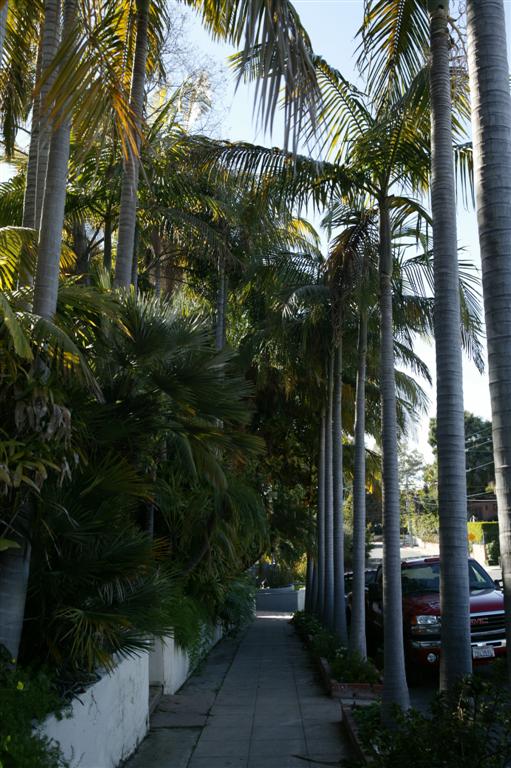
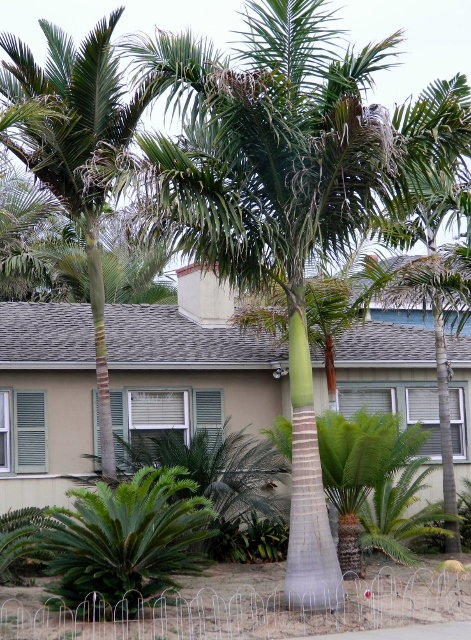
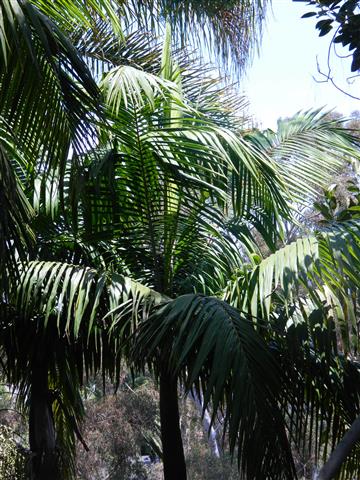

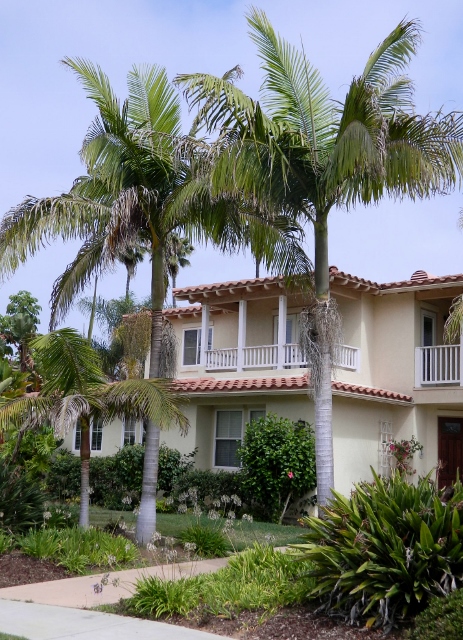
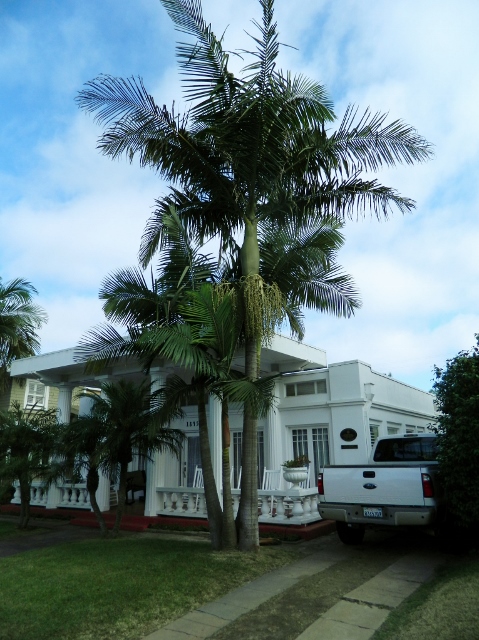
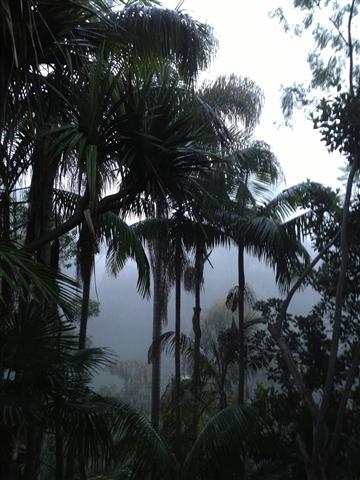
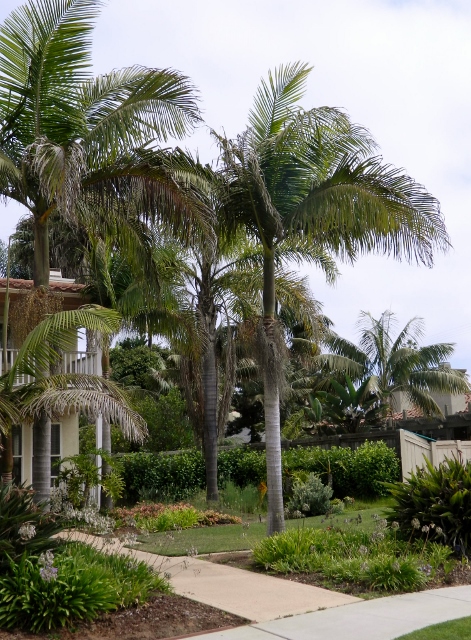
King Palms in public planting areas or parks
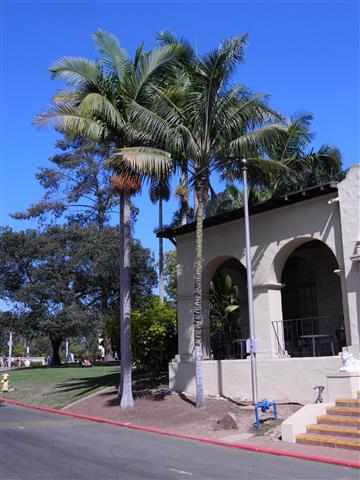
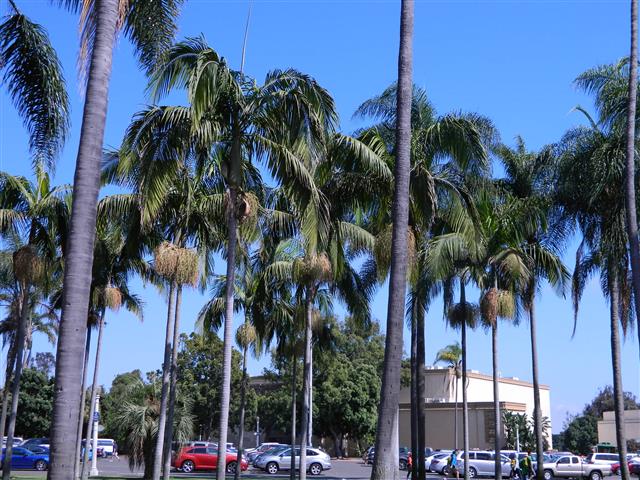
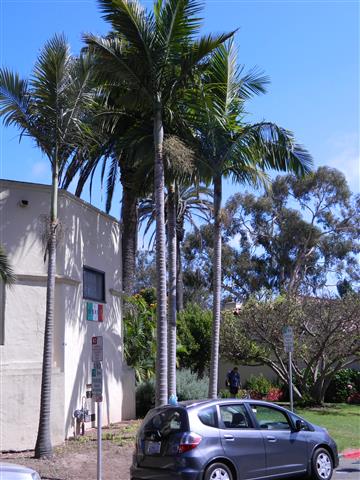
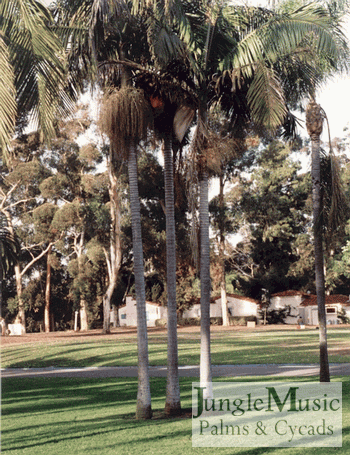
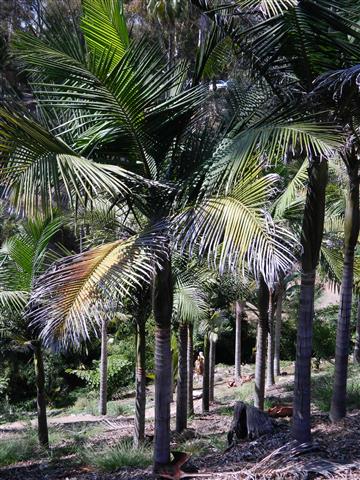
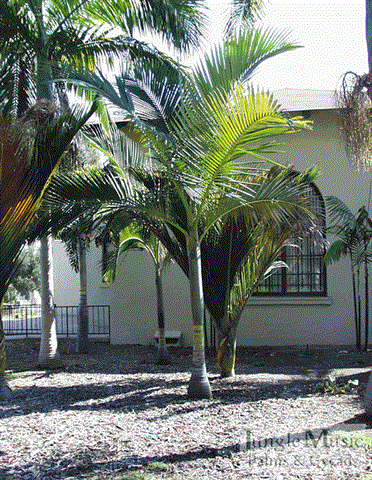
King Palm usage in commercial properties or buildings
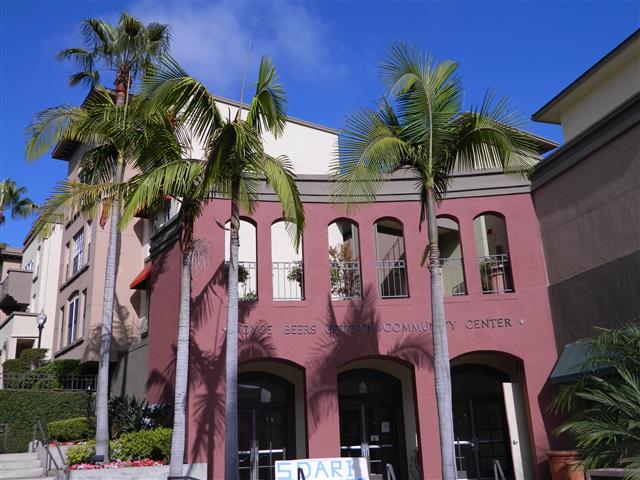

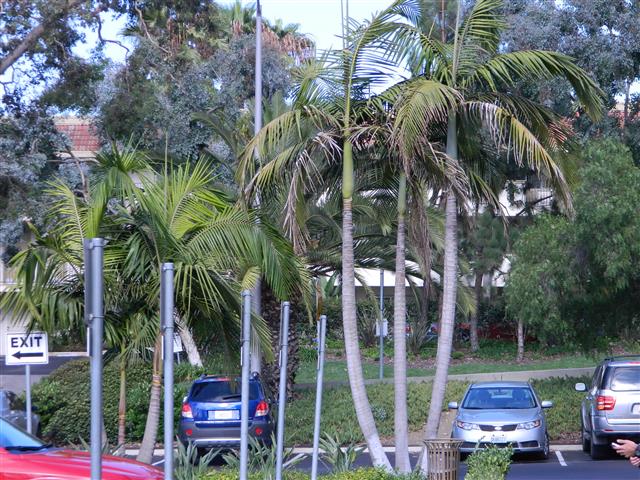
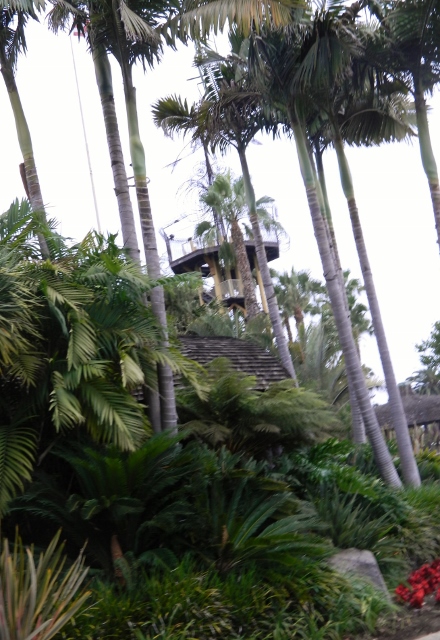
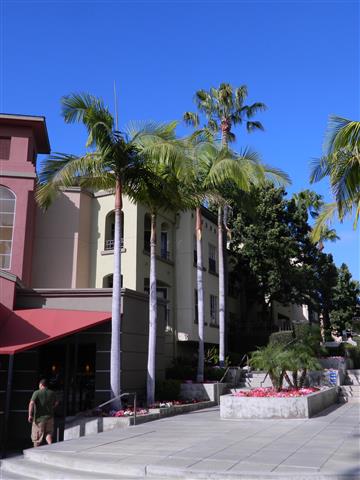
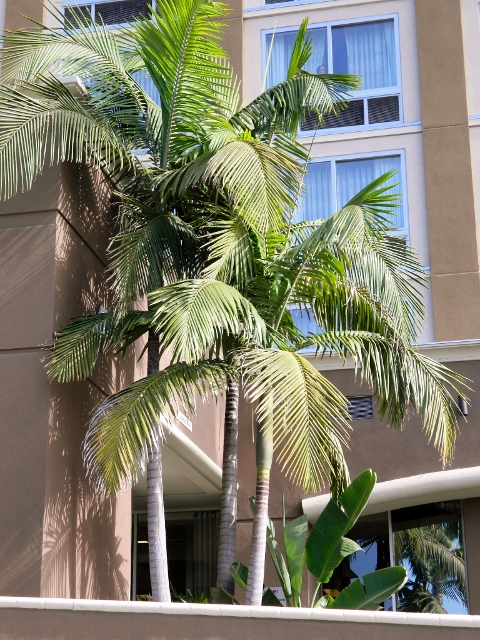
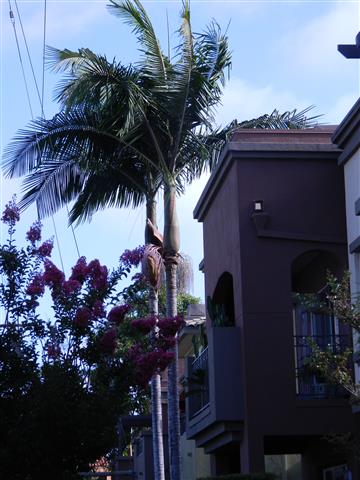
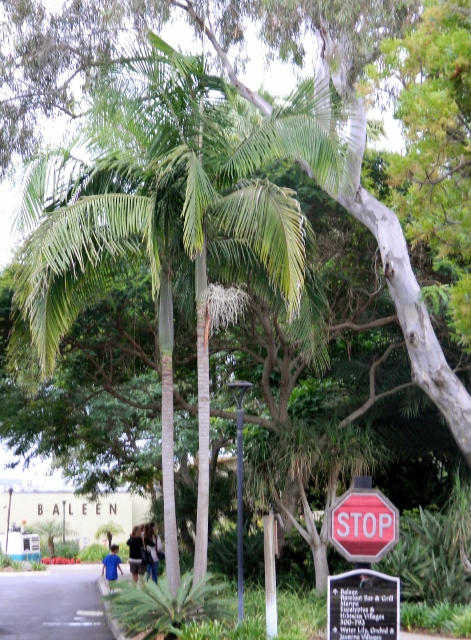
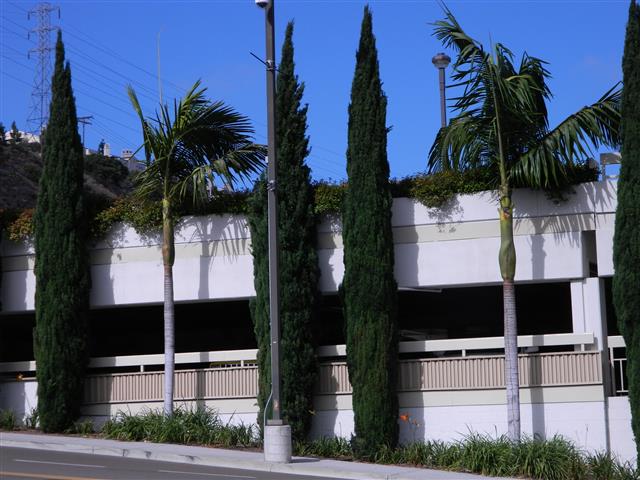
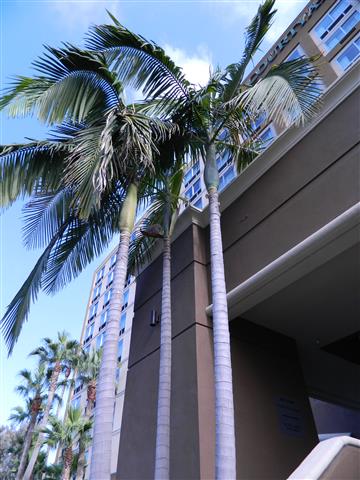
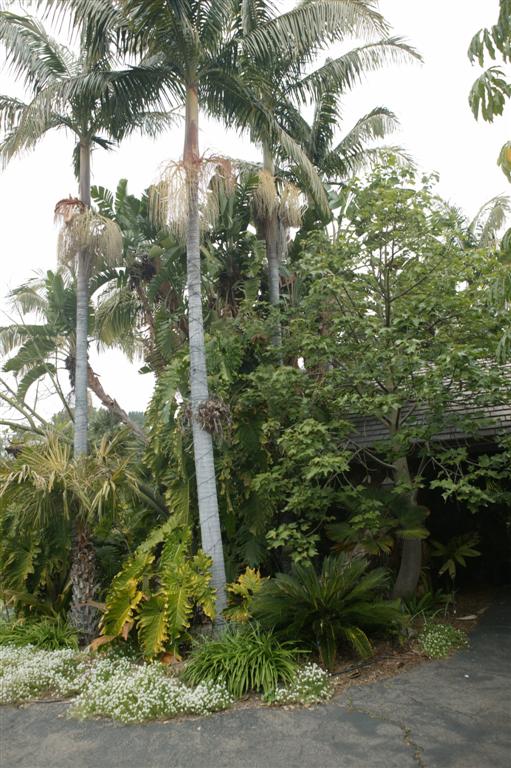
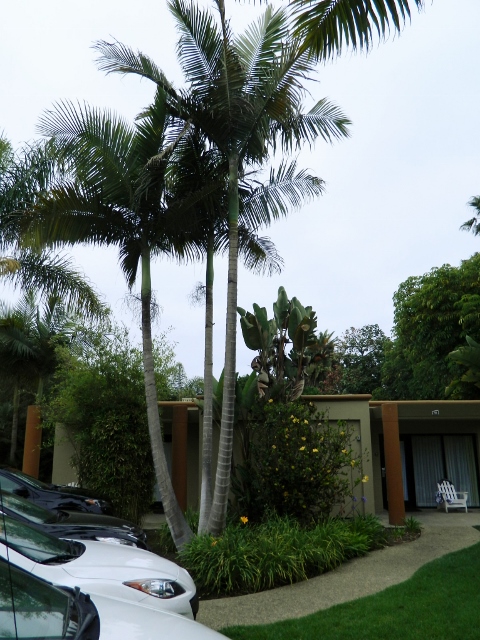
PLANTING SINGLE PALM OR MULTIPLES (TRIPLES)
One commonly sees King Palms planted in groups of three or more plants. Compare this to a single palm in the garden. Many find multiple plants together more aesthetic. The number can be two, three, or more plants. There are two ways to do this. First is the plant closely together individually grown plants. When you do this, you tend to get multiple plants going straight up, side by side. There is no ‘curving” to the trunks. In contrast, when a nursery plant is grown from a seedling stage as multiple plants in the same container, you tend to get the trunks curving away from each other to make room for the clump. This curve to the base of the trunks is usually what people are looking for. This is critical because individually planted king Palms will never really give you that basilar curving if that’s what you want. Also, when grown from a small plant as a multiple, one tends to get a dominant plant and a “runt” that is shorter. Sometimes this is very apparent, sometimes subtle. Such plantings of “multiples” puts each of the individual plants in competition. And, there’s usually a winner and a loser. I tell customers you get “Daddy, Mommy and the baby” and this is often the case. Over many decades, these differences in size and height may diminish.
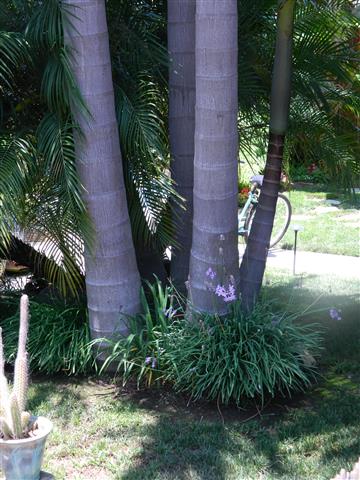
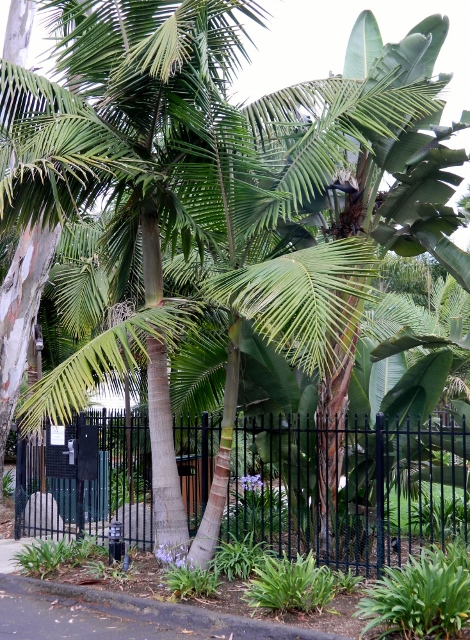
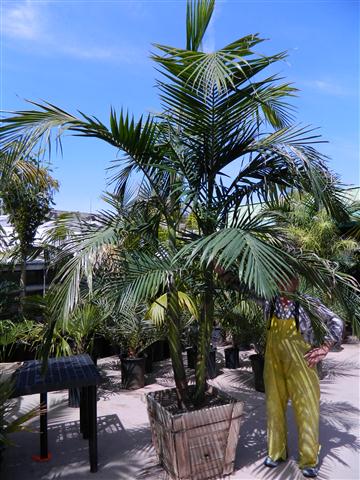
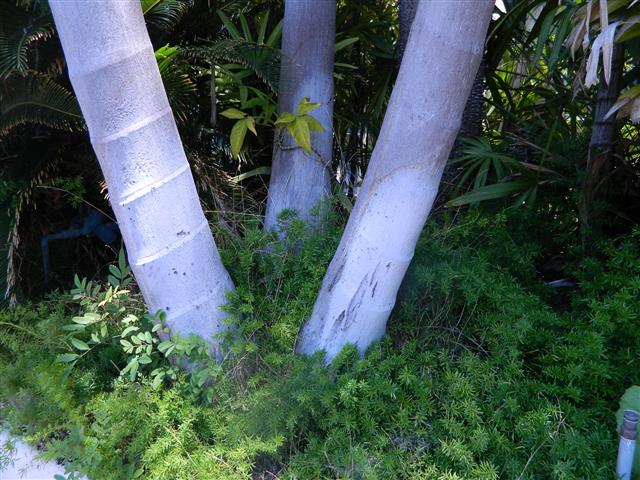
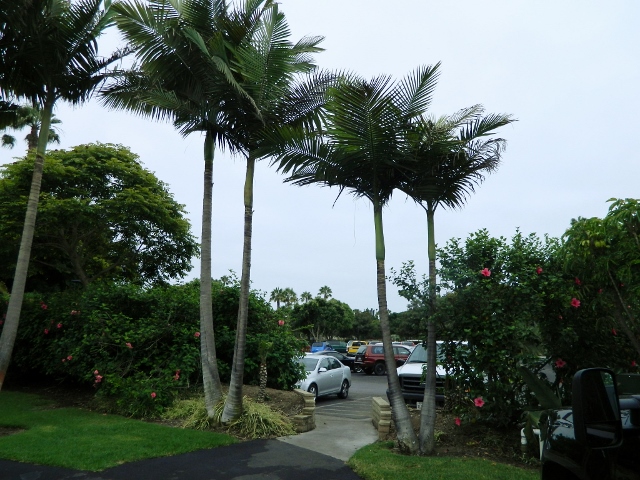
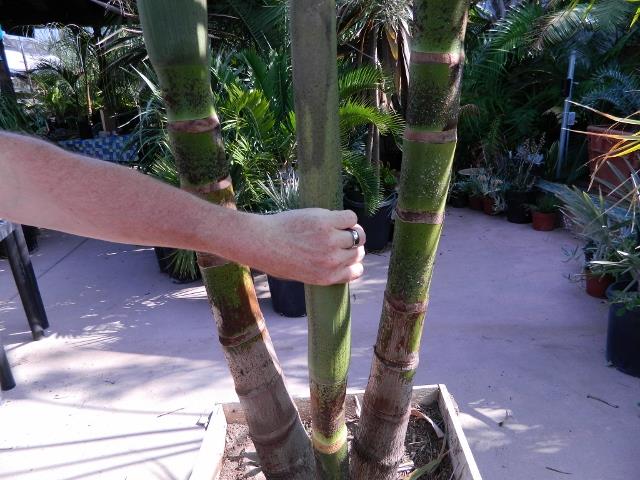
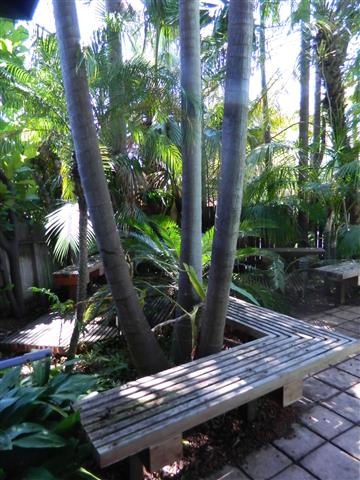
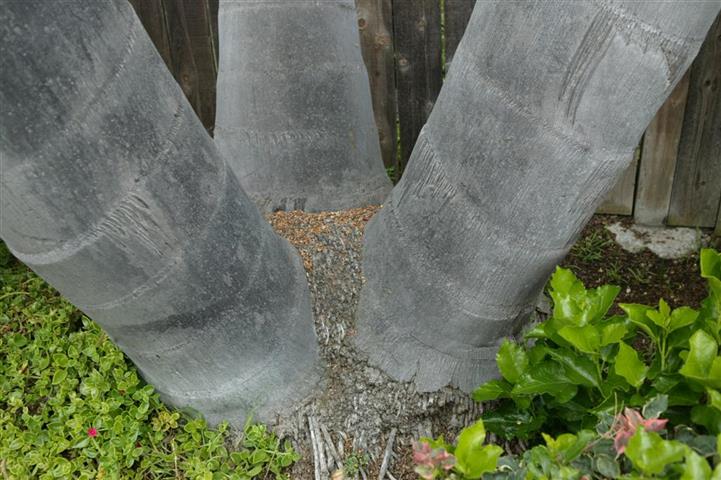

CONCLUSION
The are six different species in the King Palm group. All are of the genus Archontophoenix. Ways to tell all six species apart are described above. All are single trunk, crown shafted pinnate palms. Some have silver coloration to the underside of the leaves/leaflets. Some have different colors to their crown shafts. Heights range from about forty feet to eighty feet. Trunk diameter is usually about a foot or a bit more or less. All trees have flowers and fruits are red. All have cold tolerances of no less than 23 degrees and suffer badly below 25 degrees. Growth rate is quick. All types of King Palms like sun, but if you live in a drier area they prefer part day sun. Otherwise, “tip burn” can occur. In desert areas, they do not take any sun. King Palms love water and rich soil. With good conditions, they quickly put on trunk height. Planting is groups of three (triples) gives an aesthetic look to the clump. But, such triples should be grown as such from their onset as a nursery plant. In gardens and commercial jobs, these plants are elegant and very appealing.
Acknowledgments for photographs and information:
J. Cruickshank
Luke Nancarrow
Tobias Spanner, R.P.S.
Paul Denton
John Dowe
Palm and Cycad Society of Australia
Phil Bergman
Owner
- PALM TREES, CYCADS & TROPICAL PLANT BLOG - October 1, 2020
- TRACHYCARPUS
The Windmill Palm - September 30, 2020 - FAN PALMS –
PALMS WITH CIRCULAR LEAVES - September 29, 2020
